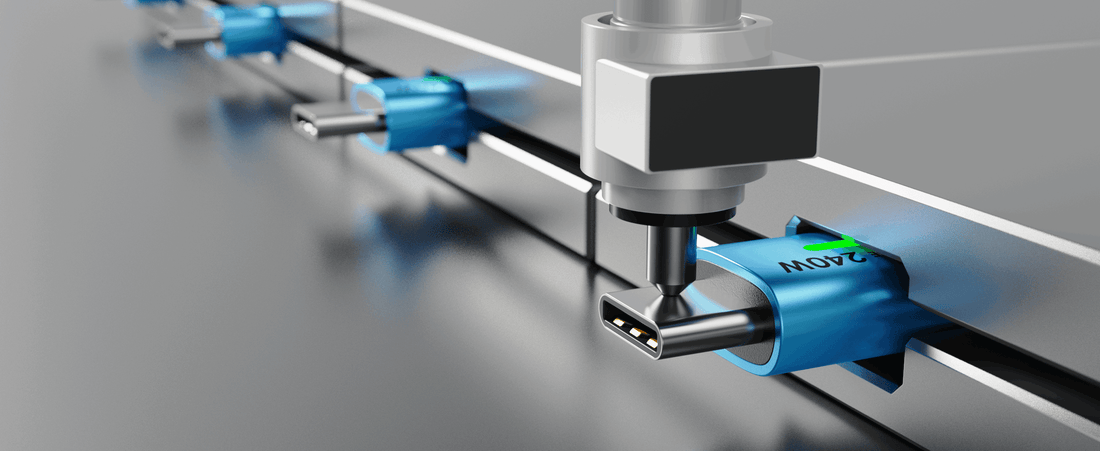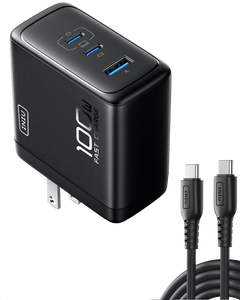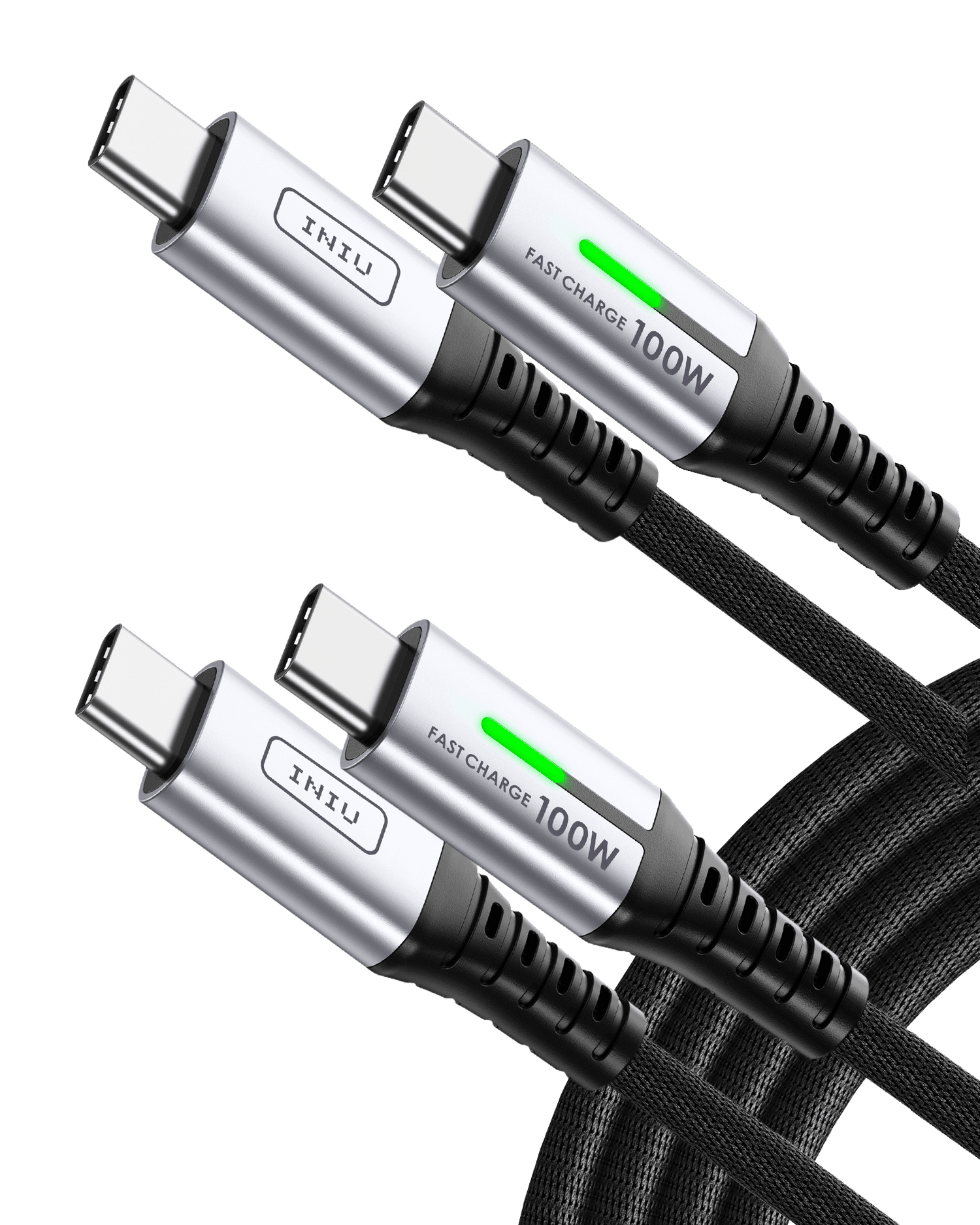
The Rise of USB-C: Faster, Stronger, Smarter
Remember the drawer full of tangled cables? One for your old Android, another for your Kindle, a different one for your camera, and a special one just for your iPhone. Finding the right cable was a daily scavenger hunt. USB-C is the hero that swooped in to end that chaos. It's the one-size-fits-all, super-powered connector that's finally unifying our tech. It's not just a new plug; it's a smarter, faster, and ridiculously convenient way to connect everything.
Say Goodbye to Cable Chaos
We've all been there: a tangled mess of USB-A, Micro-USB, and Lightning cables cluttering our drawers and bags. This section explores how USB-C emerged as the ultimate solution to this universal problem.
Clutter and Confusion
For years, the world of consumer electronics was a wild west of connectors. The standard rectangular USB-A port was the king of computers and wall chargers, but it was too bulky for the sleek new smartphones and tablets taking over our lives. This led to a frustrating proliferation of smaller, device-specific cables. Android phones, cameras, and countless accessories adopted the trapezoidal Micro-USB, while Apple carved its own path with the proprietary 30-pin connector and later, the Lightning port.
The result was a chaotic ecosystem. Many people had problems because they couldn't power up their phones due to incompatible chargers. Traveling meant packing a dedicated cable for each device. This fragmentation wasn't just inconvenient; it was costly and created a mountain of electronic waste as old, proprietary chargers became obsolete with every new device purchase.
Adding to the daily annoyance was a fundamental design flaw in both USB-A and Micro-USB: they weren't reversible. We've all experienced the "USB paradox"—fumbling to plug in a cable, flipping it over, and then flipping it back again before it finally fits. It was a small but constant reminder that our technology wasn't as user-friendly as it could be.
A Universal Solution Emerges
USB-C arrived as a direct answer to this chaos. Developed by the USB Implementers Forum (USB-IF), a consortium of tech giants including Apple, Google, Intel, and Microsoft, it was designed from the ground up to be a single, universal connector for everything. Its goal was to replace the entire collection of legacy USB ports—A, B, Mini, and Micro—with one sleek, powerful, and future-proof standard.
The most immediately obvious benefit was its design. Small, oval-shaped, and perfectly symmetrical, the USB-C connector is completely reversible. That frustrating plugging-in ritual was gone for good. You could grab the cable in the dark and connect it on the first try, every time. This simple improvement not only enhanced convenience but also reduced wear and tear on both the port and the cable, as users no longer had to force a connection the wrong way.
But the reversible design was just the beginning. USB-C was built to be a powerhouse, capable of handling high-speed data transfer, immense power delivery for charging laptops, and even native video output—all through a single, compact port. It was the all-in-one solution the tech world desperately needed to finally untangle our digital lives.
What Is USB-C? A Quick Refresher
USB-C is more than just a new shape; it's a sophisticated platform for power, data, and video. This section breaks down what makes this small connector so incredibly capable and versatile.
The Connector and Its Capabilities
At its core, USB-C is the physical connector—a compact, oval-shaped plug with 24 pins inside, a huge leap from the four pins in USB-A or the five in Micro-USB. This robust design is slim enough for the thinnest smartphones yet strong enough for laptops and monitors. It's built to last, rated for a minimum of 10,000 insertion and removal cycles, which translates to years of reliable use.
What's crucial to understand is that the term "USB-C" only describes the physical port. The speed and features of that port depend entirely on the technology the device manufacturer decides to build into it. Think of the USB-C port as a multi-lane superhighway; the protocols are the types of vehicles that can travel on it. A device can have a USB-C port that's just a simple country road (supporting slow USB 2.0 data speeds) or one that's a full-blown autobahn (supporting blazing-fast USB4 and Thunderbolt).
This explains why, for example, the standard iPhone 15 has a USB-C port that transfers data at the same pokey 480 Mbps speed as the old Lightning cable, while the iPhone 15 Pro's USB-C port can hit speeds up to 10 Gbps—more than 20 times faster. Same port, different capabilities.
The Protocols: Power, Data, and Video in One
The magic of USB-C lies in the powerful protocols it can support. These are the "brains" that unlock its full potential.
- USB Power Delivery (PD): This is the intelligent charging protocol that transforms USB-C from a simple power cable into a smart, high-wattage charging solution. With PD, the charger and the device communicate to determine the optimal amount of power needed, ensuring a fast and safe charge. It allows for bi-directional power, meaning your laptop can charge your phone, or your monitor can power your laptop. Standard PD can deliver up to 100 watts of power—enough for most laptops—while the newer Extended Power Range (EPR) standard pushes that limit to an incredible 240 watts, capable of powering even high-performance gaming rigs.
- Alternate Modes: This feature allows a USB-C port to act like a different type of connection altogether. The most common is DisplayPort Alternate Mode, which lets you connect your laptop or tablet directly to a high-resolution monitor using just a USB-C cable—no clunky adapters needed. It can also support HDMI and other protocols, making USB-C a true "one port to rule them all" for video output.
- High-Speed Data Protocols: The USB-C connector is the physical platform for the latest and greatest data transfer standards. While it can support basic USB 2.0 (480 Mbps), its real strength is in handling modern protocols like USB 3.2, which offers speeds from 5 Gbps up to 20 Gbps, and USB4, which hits a staggering 40 Gbps. It's also the connector of choice for Thunderbolt, Intel's super-powered protocol that combines ultra-fast data, video, and power into the ultimate high-performance connection.
USB-C vs Traditional Cables: A Side-by-Side Comparison
To truly appreciate USB-C's leap forward, it helps to see how it stacks up against the old guard. This head-to-head comparison reveals why it's the undisputed champion of modern connectivity.
The Ultimate Connector Showdown
When you line up the specs, the difference is night and day. USB-C wasn't just an incremental improvement; it was a fundamental redesign that addressed the shortcomings of every connector that came before it. The following table breaks down the key differences, showing a clear pattern of USB-C's superiority across the board.
| Feature | USB-C | Lightning | USB-A | Micro-USB |
| Shape & Reversibility | Small, Oval, Reversible | Small, Reversible | Large, Rectangular, Not Reversible | Small, Trapezoidal, Not Reversible |
| Max Data Speed | Up to 80 Gbps (USB4 v2.0) | 480 Mbps (USB 2.0) | Up to 10 Gbps (USB 3.2 Gen 2) | 480 Mbps (USB 2.0) |
| Max Power Delivery | Up to 240W (with EPR) | ~27W (with USB-C PD adapter) | Up to 12W | Up to 15W |
| Native Video Output | Yes (DP/HDMI Alt Mode) | No (Requires adapter) | No (Requires adapter) | No |
| Primary Point of Wear | Cable (Replaceable) | Device Port (Expensive) | Device Port | Device Port |
| Adoption Trend | Universal Standard | Apple-only (being phased out) | Legacy (declining) | Legacy (declining) |
Why It's Not Even a Fair Fight
The data speaks for itself. In terms of raw power, USB-C can deliver up to 240 watts, dwarfing the ~12W of USB-A and the ~27W that Lightning can handle even with a special adapter. This is the difference between slowly trickling power into a device and rapidly charging a high-performance laptop.
For data speed, the gap is even wider. Lightning and Micro-USB are stuck in the past, operating at sluggish USB 2.0 speeds of 480 Mbps. USB-A can reach a respectable 10 Gbps with the right port, but USB-C, when paired with USB4 or Thunderbolt, can hit a mind-bending 40 Gbps or even 80 Gbps with the latest standards. That means transferring a full-length 4K movie in seconds, not minutes.
Perhaps the most significant advantage is versatility. USB-C is the only connector in the group that can natively handle high-resolution video output through its Alternate Modes. With older connectors, you need a separate HDMI or DisplayPort cable. With USB-C, a single cable can charge your laptop, connect it to an external 4K monitor, and transfer files from an external drive—all at the same time. It's this convergence of power, data, and video that truly sets USB-C apart, transforming it from just another cable into a universal docking solution.
Why USB-C Is Winning
USB-C's rise to dominance wasn't an accident. It was driven by a perfect storm of technical superiority, widespread industry support, and a powerful regulatory push that made it the undisputed global standard.
Universal Compatibility Across Devices
The number one reason for USB-C's victory is its universality. For the first time, we have a single, high-performance port that works on everything. Laptops from Dell, HP, and Apple; smartphones from Samsung and Google; tablets like the iPad Pro; and even gaming consoles like the Nintendo Switch have all adopted USB-C. This cross-platform compatibility is a massive win for consumers. It means you can use the same charger for your MacBook and your Android phone, or borrow a friend's cable without worrying if it will fit. This simplifies our tech lives, reduces the number of accessories we need to buy and carry, and cuts down on electronic waste.
High-Speed Data Transfer and Power Delivery
USB-C isn't just universal; it's also incredibly powerful. The integration of USB Power Delivery (PD) allows it to intelligently and safely deliver up to 240W of power, turning it into a fast-charging solution for everything from tiny earbuds to power-hungry gaming laptops. This has dramatically reduced charging times for compatible devices.
Simultaneously, its support for cutting-edge data protocols like USB4 and Thunderbolt 4 (both running at 40 Gbps) provides the massive bandwidth needed for modern, high-performance tasks. Whether you're editing 8K video from an external SSD, running multiple 4K displays, or connecting to an external GPU for gaming, USB-C has the speed to handle it without breaking a sweat.
Convenience of Reversible Design
It might seem like a small thing, but the user-friendly, reversible design of USB-C was a game-changer. The daily frustration of fumbling with non-reversible USB-A and Micro-USB plugs was a universal pain point. USB-C's symmetrical connector, which clicks in perfectly every time, eliminated this annoyance and created a more satisfying and reliable user experience. This thoughtful design also helps extend the lifespan of ports and cables by preventing the damage that can occur from trying to force a connection the wrong way.
Industry and Regulatory Momentum
The tech industry was quick to embrace USB-C for its technical merits. Laptop makers loved it because it allowed them to build thinner, lighter devices with fewer ports. But the final, decisive push came from regulators. The European Union, in a landmark move to reduce e-waste and improve consumer convenience, mandated that all new smartphones, tablets, and cameras sold in the EU must use a USB-C charging port by the end of 2024. This forced Apple, the last major holdout, to switch the iPhone from its proprietary Lightning port to USB-C. Because it's impractical for global companies to make different versions of their products for different regions, the EU's decision effectively created a new global standard, with other countries like India quickly following suit.
What Does USB-C Adoption Mean for You as a Consumer?
The universal shift to USB-C isn't just a technical upgrade for manufacturers; it brings a host of tangible, real-world benefits that simplify your daily life and make your technology more powerful and efficient.
One Cable, Zero Hassle
The most immediate benefit is the sheer convenience of a universal standard. Imagine traveling with just one cable and one power brick to charge your laptop, phone, tablet, headphones, and portable speaker. No more packing a tangled mess of different chargers or frantically searching for the right cable. The dream of a single, unified charging ecosystem is finally a reality. This compatibility extends beyond your own devices; you can easily borrow a charger from a friend or colleague, regardless of whether they use an Apple or Android device.
Supercharge Your Devices
With USB-C Power Delivery (PD), waiting hours for your devices to charge is a thing of the past. When paired with a compatible PD charger, you can power up a smartphone to 50% in about 30 minutes. Laptops that once required bulky, proprietary power bricks can now be charged quickly with a compact and universal USB-C charger. This isn't just about speed; it's about flexibility. You can charge your laptop from a portable power bank or even use your laptop to give your phone a quick power boost, thanks to USB-C's bi-directional charging capability.
Future-Proof Your Tech Setup
Switching to USB-C is an investment in the future. Legacy ports like USB-A and Lightning are being phased out, and new devices are overwhelmingly adopting USB-C as the standard. As you upgrade your tech, prioritizing devices with USB-C ports ensures they will remain compatible with the growing ecosystem of accessories, docks, and monitors for years to come.
For those still using older devices, the transition can be managed smoothly. High-quality adapters and hubs can bridge the gap, allowing you to connect your legacy USB-A peripherals to a new USB-C laptop. However, it's important to choose accessories from reputable brands to avoid the risks associated with cheap, non-certified cables, which can fail to regulate power correctly and potentially damage your expensive electronics. Moving forward, investing in a good set of USB-C cables, a powerful GaN charger or a more powerful USB-C power bank is the smartest way to build a streamlined, efficient, and long-lasting tech setup.
Future of USB-C: Is This the Final Cable Standard?
With USB-C now firmly established as the universal connector, it's natural to wonder what's next. While the tech world never stands still, USB-C is so well-designed and adaptable that it's poised to remain the dominant standard for a long time.
The Road Ahead Is Paved with USB-C
The beauty of USB-C is that the physical connector is a stable platform for ever-evolving protocols. The future isn't about replacing the USB-C port itself, but about making what runs through it even faster and more powerful. We're already seeing this with the next generation of standards:
- USB4 Version 2.0: This upcoming standard will double the top speed to an incredible 80 Gbps. It also introduces an ingenious asymmetric mode that can push up to 120 Gbps in one direction—perfect for driving next-generation 8K and even 16K displays—while still providing 40 Gbps in the other.
- Thunderbolt 5: Built on the USB4 v2.0 foundation, Thunderbolt 5 will offer these same blazing speeds but with a guarantee of top-tier performance for creative professionals and gamers, along with up to 240W of power delivery.
These advancements show that the USB-C connector has plenty of headroom to support our technological needs for the next decade and beyond. It's not a temporary solution; it's a forward-looking platform built for growth.
What About a Wireless Future?
Wireless charging technologies like Qi and MagSafe are incredibly convenient for topping up your phone overnight on a nightstand. However, they are unlikely to replace wired connections entirely, at least not anytime soon. The laws of physics present some hard limits. Transferring power wirelessly is inherently less efficient than through a wire, with a significant percentage of energy lost as heat.
Furthermore, wireless charging can't compete with the sheer speed and power of a wired USB-C PD connection. While a wireless pad might offer 15W of power, a wired USB-C cable can deliver over 100W, charging devices many times faster. Wires also remain essential for high-speed data transfers, like backing up your entire phone or moving large video files, where wireless methods are still comparatively slow and less reliable. For the foreseeable future, the future is hybrid: wireless for low-power convenience and USB-C for speed, power, and performance.
The Future Is USB-C: Unified, Powerful, Here to Stay
USB-C has done more than just clean up our cable drawers. It has created a single, unified standard that simplifies our lives, supercharges our devices, and reduces electronic waste. Its combination of a user-friendly design, incredible power, and massive data bandwidth has secured its place as the undisputed king of connectors. As technology continues to advance, the versatile USB-C port is ready to handle whatever comes next, proving it's the one cable we'll be relying on for years to come.




